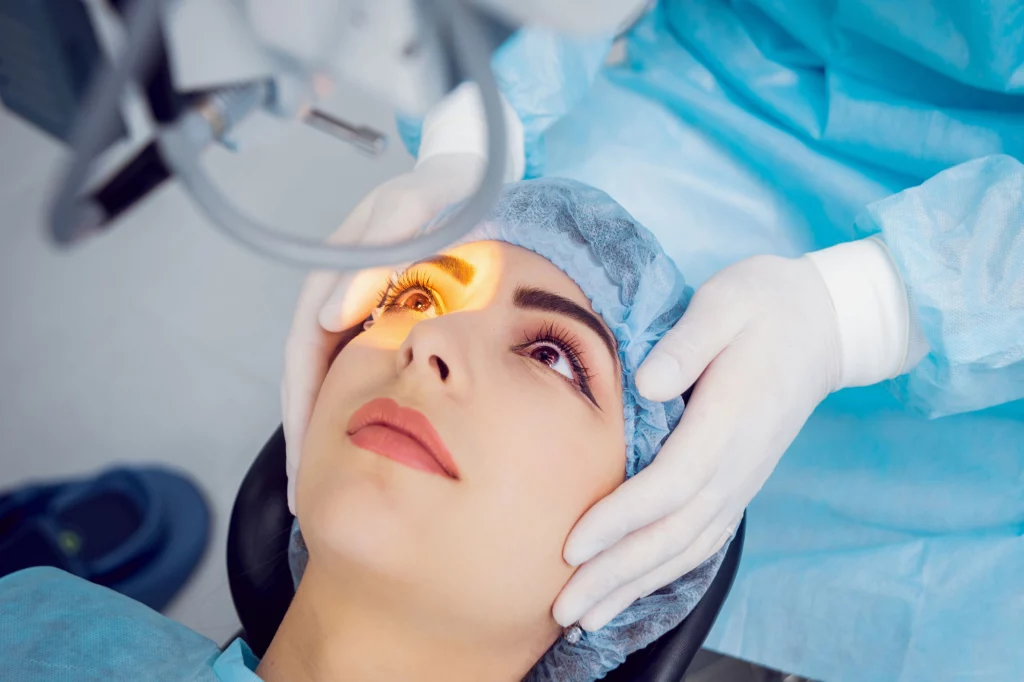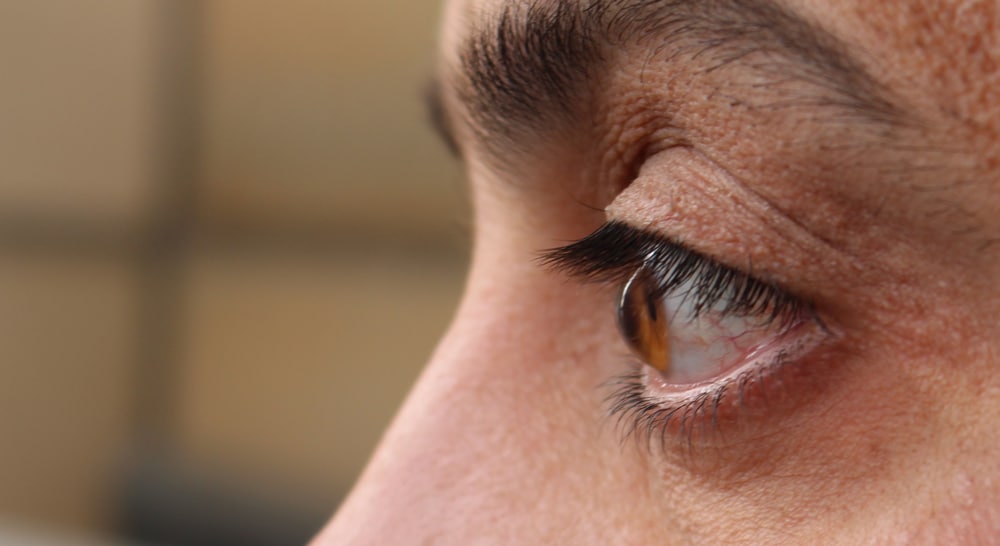Medically Reviewed by: Edward C. Wade, M.D., F.A.C.S.
Pros and Cons of Photorefractive Keratectomy
For many patients, the dream of clear vision without the hassle of glasses or contact lenses may be a reality thanks to advancements in vision correction procedures like photorefractive keratectomy (more commonly known as PRK or PRK LASIK).
Photorefractive keratectomy, or PRK, is a safe and effective alternative to LASIK surgery, for those who don’t qualify as candidates for LASIK. However, as with any medical procedure, there are things to consider when deciding if PRK eye surgery is right for you.
The ophthalmologists at Eye Center of Texas are here to shed light on the PRK eye surgery pros and cons, what to expect during the surgery and recovery, and who might and might not be an ideal candidate. We’re hoping that this will help you to make an informed choice for your ocular health.
| Photorefractive Keratectomy Pros | Photorefractive Keratectomy Cons |
|
|
What is PRK surgery?
Photorefractive keratectomy (PRK) is a type of refractive surgery that can correct common vision problems such as mild to moderate nearsightedness, farsightedness, and astigmatism. The PRK procedure itself is fairly short, lasting only around 15 minutes long. The surgery reshapes the cornea, the clear front part of the eye, so that light is focused properly onto the retina.
The difference between PRK and LASIK is that unlike LASIK, which creates a flap in the cornea, PRK gently removes the outer layer of the cornea before reshaping it with an ultraviolet beam of light. Once the cornea is reshaped, a “bandage” contact lens is placed over the eye to help protect the surface as it heals. The top layer of the cornea eventually grows back over the reshaped internal layers.
Want to know if PRK eye surgery is the best vision correction procedure for you? Let’s discuss the PRK eye surgery pros and cons.
What are the advantages of photorefractive keratectomy?
Here is a list of reasons why getting PRK may be beneficial for you and your vision.
1. PRK is typically safer than LASIK
Is PRK surgery safe? Yes! Since PRK does not leave a flap in your cornea like LASIK does, you are less likely to deal with complications such as flap displacement, wrinkling, or unexpected growth.
PRK is seen as safer for patients who have:
- Dry eye condition
- Active lifestyle preferences
- High corrective prescription (meaning you are more farsighted)
- Thin corneas
How safe is photorefractive keratectomy?
While every medical procedure has its risks, such as infection or miscorrection, PRK is considered a low-risk procedure when performed by a skilled eye surgeon. Because PRK does not require anesthesia, many patients worry about pain, but there’s no need to be anxious. Your ophthalmologist will use numbing drops in your eyes before the procedure and offer an oral sedative if you feel you need it. Many patients note that PRK is quick and painless.
2. More patients qualify for PRK
A big reason that not many people qualify for LASIK is that their corneas are too thin or they deal with dry eye syndrome as stated above. However, patients with thin corneas or corneal irregularities that may complicate the flap creation from LASIK could benefit from PRK instead.
Additionally, PRK can be a suitable option for people with certain professions or hobbies that may involve contact sports or other activities where contact with the eyes is possible.
How do I know if I qualify for PRK? Here is a list of indicators that you would be an ideal candidate for PRK:
- You’re at least 18 years old
- You experience refractive errors (myopia, hyperopia, astigmatism)
- You’re not pregnant or nursing
- You’ve had a stable prescription for at least one year
- You haven’t experienced eye injuries or infection within the last year
- You’re not suffering from dry eye syndrome
- You have no issues with keratoconus
Who is a bad candidate for PRK?
Certain health and lifestyle factors could make PRK a less-than-ideal choice for vision correction surgery. Candidates who do not qualify for PRK may include:
- People with an unstable prescription
- People with a history of corneal diseases
- People with systemic health conditions (especially those affecting the immune system)
- Individuals with unrealistic expectations about the results and recovery process
3. Fewer risks and side effects
PRK has fewer and less severe side effects than a surgery like LASIK. For example, you won’t run the risk of getting dry eye syndrome from disrupted nerves. However, every vision correction surgery will come with its own set of side effects to be aware of.
Common PRK side effects to keep an eye out for in the first week of recovery include:
- Mild to moderate discomfort or itching
- Light sensitivity
- Seeing bursts or halos of light for the first few weeks
- Cloudy or hazy vision (corneal haze)
4. High success rate
The PRK success rate is very high, making it a popular choice among patients. According to the FDA, about 95% of PRK patients achieve 20/40 vision without the need for corrective lenses or glasses after one-year post-op. This means that many patients can throw out their glasses or contacts within a year of getting PRK.
5. Long-term results
During the initial healing phase, the outer layer of the cornea regenerates, leading many ophthalmologists to believe that PRK offers a more stable and long-term outcome compared to LASIK. The gradual healing process also means that the vision may take longer to fully stabilize, but the results are often more predictable.
What are the cons of PRK surgery?
While photorefractive keratectomy may come with many benefits, it also is accompanied by a short list of things that all patients should consider before committing to PRK.
1. Longer recovery time
PRK recovery is a little longer than LASIK due to the nature of the surgery. Where the corneal flap can simply be realigned after LASIK, the outer layer that was scraped away during PRK needs time to grow back. Patients can expect to be fully recovered within 2-4 weeks of getting PRK, but recovery time may depend on the individual patient’s circumstances.
2. Discomfort and sensitivity
Due to the removal of the protective outer layer of the cornea during PRK, the initial days following the procedure can bring a little more discomfort than LASIK or other surgeries. Patients often experience some mild pain, light sensitivity, or hazy vision which generally subsides within a few days as the cornea begins to regenerate. Make sure to not do any strenuous exercise or activities while you’re in recovery.
3. Possibility of vision overcorrection or undercorrection
In the event that your vision was over or undercorrected during your surgery, you may need to go back to glasses or contacts or even get an additional surgery to remedy the problem. Although it is rare, there is a possibility that your vision could worsen after getting PRK. Being aware of these possibilities and speaking to your doctor about them will make the process a lot smoother.
4. Risk of infection
Because PRK requires removing the outer layer of the cornea which serves as a natural protective barrier, your eyes are slightly more vulnerable to infection post-PRK. However, this risk can be minimized greatly if you are diligent about your post-operative dos and don’ts.
PRK dos and don’ts:
Do:
- Follow up with your doctor
- Use your eye drops as prescribed
- Wear sunglasses to avoid bright lights
- Consult your doctor before and after your procedure about medications to help with possible discomfort
Don’t:
- Rub or touch your eyes
- Participate in strenuous activities
- Drive until you are safe to do so
- Swim
- Put on makeup or any cream products near your eyes
- Smoke
Is photorefractive keratectomy right for you? Ask the ophthalmologists at Eye Center of Texas.
Photorefractive keratectomy is a great surgical option for those who don’t want to wear glasses or contact lenses for the rest of their lives but don’t qualify for LASIK. With its safety, high PRK success rate, and high rate of patient satisfaction, PRK may also be the right choice for you.
The best way to determine if PRK is right for you is to schedule a consultation with an experienced eye surgeon. During this visit, your eyes will be thoroughly examined, and your surgeon will discuss your candidacy, potential risks, and what to expect throughout the process.
At Eye Center of Texas, our talented PRK surgeons including Dr. Yasir Ahmed, M.D., Dr. Mark Mayo, M.D., and Dr. Edward Wade, M.D., F.A.C.S. have helped countless patients get their desired vision with PRK. With their expertise, you can rest assured that your vision is in the best hands.
Ready to get started? We offer photorefractive keratectomy at our locations throughout Texas including Houston/Bellaire, Pasadena, Sugar Land, Clear Lake, Katy, and The Woodlands/Conroe. Request an appointment today to see if you are a candidate for PRK!
More Helpful Articles by Eye Center of Texas:
- How Old Do You Have to Be to Get LASIK?
- What To Do About Double Vision After Cataract Surgery
- Why Is My Vision Getting Worse?
- Why Patients Say We Are the Best Ophthalmologists in Texas
- 7 Things To Do When Preparing for LASIK Surgery
Related Articles
Financing Options Available
Apply today to find a financing option that meets your needs.
Our Locations
Houston/Bellaire
6565 W. Loop S., Suite 650Bellaire, TX 77401
Medical Office:
713-797-1010
Medical Fax:
713-357-7276
LASIK/Near Vision:
Office: 713-395-1515
Fax: 713-357-7278
Pasadena
4415 Crenshaw RoadPasadena, TX 77504
Medical Office:
281-977-8800
Medical Fax:
281-977-8877
Sugar Land
15200 S.W. Freeway, Suite 130Sugar Land, TX 77478
Medical Office:
281-277-1010
Medical Fax:
281-277-4504
Clear Lake
455 E. Medical Center Blvd., Suite 110Webster, TX 77598
Medical Office:
281-332-1397
Medical Fax:
281-282-9152
Katy
Greenhouse Medical Plaza2051 Greenhouse Road, Suite 110
Houston, TX 77084
Medical Office:
346-547-7070
Medical Fax:
281-214-2971
The Woodlands/Conroe
100 Medical Center Blvd., Suite 118Conroe, TX 77304
Medical Office:
936-647-1610
Medical Fax:
936-647-1620


